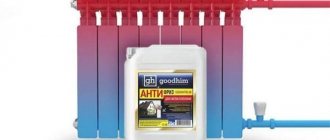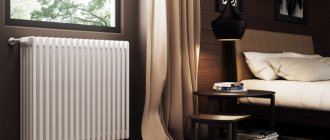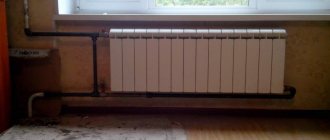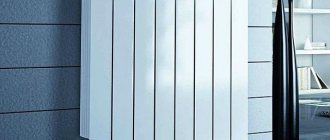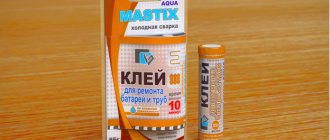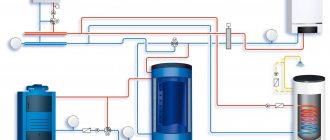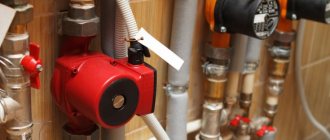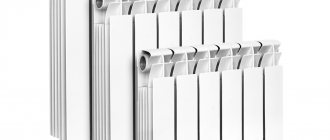Since ancient times, ordinary water has been used as a coolant in heating systems. The specific heat capacity of water reaches 4.168 kJ/kg, which is very good. In addition, the price of this coolant is low. But the water poured into the radiator has one significant drawback, namely, freezing in the cold season when the boiler is turned off.
This problem is well known to the owners of country cottages and dachas, where residence is irregular. By turning off the autonomous system for several days in winter and not draining the water, you can be sure that the pipes or batteries will fail. Damage to heating devices will occur due to the expansion of water when freezing, and as a result, the batteries may simply burst.
Consequences of coolant freezing
The real solution in this situation is antifreeze for aluminum radiators. There is a wide range of these liquids on the market, and therefore you can choose products for both the ubiquitous aluminum and bimetal, steel and cast iron. If desired, you can purchase universal products that can be poured into any system without compromising the efficiency of its operation.
Important: The main requirements that need to be taken into account when choosing antifreeze are fire safety and the absence of toxic additives that can enter the room along with fumes.
Which batteries are better to install in an apartment, and which ones in a private house?
Almost all types of radiators can be installed in a house or apartment, but there are some restrictions.
For apartments it is not recommended to: install steel panel-type radiators, since they have a fairly low operating pressure of only 6-8 atm, whereas in a centralized heating system the pressure can reach 10 atm, which can lead to deformation of the collector. Also, in such a system it is not recommended to use aluminum radiators, in which galvanic corrosion occurs when interacting with various metals.
In apartments with centralized heating, it is recommended to use bimetallic and cast iron radiators, which are the most resistant to corrosion and have a long service life.
In private homes, you can use all radiators, of any type, without exception, the main thing is to correctly calculate the required power. But, there are recommendations.
There are also restrictions on the use of various types of radiators in closed and open heating systems. In systems with forced circulation, all of the above radiators can be used, but for systems with natural circulation, only cast iron and aluminum batteries are suitable. They have fairly wide connecting holes between the upper and lower collectors, which promotes uniform heating of the battery over its entire height.
If antifreeze is a heat carrier
If you decide to use ethylene glycol-based antifreeze as a liquid heated in the radiator, then you need to choose radiators of higher power. After all, antifreeze has a higher viscosity than water, therefore, more powerful pumps and units are needed to move antifreeze through pipes. Thanks to the density of antifreeze, heat will be firmly maintained in the country house.
Aluminum's susceptibility to corrosion should also concern cottage owners. But antifreeze already contains anti-corrosion elements that will help keep your radiators functioning for a long time.
How to correctly calculate the power of a radiator?
All radiators have almost the same heat transfer from one section; therefore, to select the optimal radiator, you need to calculate their number. To do this, you will need the heat transfer rate of one section, which is 165 W, and the room parameters (area and height). According to SNiP, heating 1 square meter of space requires 100 W of thermal energy.
Thanks to the formula ( for cast iron, aluminum, bimetallic
) it is easy to calculate the required number of sections:
K. number of sections; S. area of the room; R. thermal power of the section.
An example of calculating the required number of radiator sections (for cast iron, aluminum, bimetallic)
Your room is 3 m by 4 m. With a standard ceiling height of 2.7 m. In this case, the room area is 12 sq.m. Then
K = 12 x 100 / 165 = 7.2, we always round up and it turns out that we need 8 sections for a room of 12 sq.m.
For panel
radiators formula is different:
R. radiator thermal power; V. volume of the room (width x height x length); 41. This is the coefficient of thermal energy that is required to warm up 1 cubic meter. premises.
An example of calculating radiator power for a panel radiator, in a room 3 m x 4 m and height 2.7 m.
V = 3 x 4 x 2.7 gives 32.4 cubic meters. Then
P = 32.4 x 41, from these calculations it follows that the thermal power of the radiator should be 1328.4 W.
Important! If your room has an external wall, the result must be multiplied by 1.2 to cover heat loss, this rule applies to all types of radiators.
How to choose heating radiators. Which ones are better?
Radiator . device for dissipating heat in air (by radiation and convection), air heat exchanger.
Today, in apartments and private houses, radiators (batteries) are most often used in the heating system. Since there are many types of batteries, does choosing the right one ensure comfort and save money? This article will help you make the right choice of radiators for heating. To do this, let’s consider what types exist, which is optimal for a private house and which for an apartment, and how to correctly calculate the power.
Conclusion
Now, at a time when we know how aluminum radiators and antifreeze get along, it is possible to decide whether it is worth using antifreeze liquids to operate autonomous heating or not. For more information, we recommend watching the video in this article.
At dachas, radiators are more relevant, since many country houses are located far from gas sources or a boiler room.
All radiators are divided into water (they heat the room using heated water) and air (using various means of heating - liquid and solid, from electricity).
There are pros and cons to any heating system . So, for example, if you decide to heat your dacha using electric heaters, then your electricity bill will not make you happy at all. A stove heater is often used in the country. But to do this, you need to stock up on the required amount of firewood or coal and store it all somewhere else. The best option for heating a dacha is aluminum radiators with antifreeze.
We consider the main types of heating radiators
Structurally, radiators are divided into sectional and panel. Sectional ones are assembled from sections that can be interconnected in the amount necessary to achieve the desired heat transfer. And panel ones. These are ready-made monolithic radiators, so you choose their size when purchasing, and there are so many of them on the website.
Cast iron radiators were common in Soviet times, they were installed everywhere without exception - both in apartments and houses. They are large in size and very heavy. But, since it is very convenient to make elegant cast products from cast iron, modern batteries are stylish and small in size, for example designer ones with artistic forging.
Features of cast iron batteries:
- The working pressure of such radiators is 5-10 atm, the test pressure is more than 15 atm;
- Compatible with all types of pipelines;
- Long service life. up to 50 years old;
- It is possible to change the number of sections;
- Heat dissipation approximately 120W
The advantages include the durability of such radiators, the service life of which reaches 30-50 years. High resistance to corrosion. As a result of operation, a protective layer appears on the inner wall, which protects it from destruction; on the outside, corrosion is almost impossible. The most common reason for battery failure is that the duct becomes clogged with calcium deposits, which can be easily prevented by softening the water or using antifreeze as a coolant, although it negatively affects the gaskets between the section connections.
The disadvantages include the fact that cast iron slowly gains temperature and cools slowly, under such conditions it is impossible to quickly regulate the temperature in the room; The heavy weight of the battery complicates its installation.
Aluminum radiators are characterized by high heat transfer, modern design and low weight, which makes installation easier. They are sold both assembled in ten sections, and separately to collect the required number of sections. Can be used for gravity heating systems.
Features of aluminum radiators:
- Light weight – for ease of installation;
- The highest heat output of all types of radiators, about 190 W;
- Working pressure 6-12 atm., test pressure 25 atm. ;
- Modern design.
The disadvantages include the fact that these radiators are suitable for use only in closed heating systems (in private houses) and are not suitable for centralized heating (apartments), in which it is impossible to control the coolant. It is not advisable to combine aluminum batteries with more noble metals. When aluminum interacts with, for example, copper or brass, the galvanic process produces small currents that cause galvanic corrosion. It is advisable to use polypropylene or plastic pipes and be sure to have grounding.
The advantages include high heat transfer; aluminum quickly heats up and cools down, so you can quickly regulate the temperature in the room. Low price compared to other radiators. Can be used in an open heating system without forced circulation.
Bimetallic radiators
Bimetallic radiators. analogue of aluminum. The only difference is that instead of an aluminum manifold (distribution tube), a steel one is used inside. This allows the use of such radiators under high pressure up to 25 atm. in centralized water supply systems.
Features of bimetallic radiators:
- High working pressure up to 25 atm;
- Compatible with any pipes;
- Light weight;
- Sectional design;
- Modern design.
Minuses. Quite a high price, about 40% higher than aluminum ones. Radiators are not compatible with non-freezing liquid (antifreeze), because... when they interact over time, a leak may occur.
Pros. Modern design, suitable for any interior, several height options, sectional connections make it possible to select the required number of sections (according to the area of the room), high thermal conductivity, low weight facilitates installation.
READ How to remove the temperature regulator from a radiator
Steel (panel) radiators.
Among all types of radiators, panel radiators are most often used in private homes. Thanks to the wide range of these radiators, there is no selection problem, and the service life will please all users without exception.
Features of panel radiators:
- Moderate cost;
- Versatility of connection;
- Service life 20-30 years;
- Modern design.
Pros. Long service life. High-quality radiators from world leaders last 20-30 years. Various options for connecting to a heating system, both traditional and single-pipe. Ease of installation. Mounting panel radiators allows you to securely mount it to the wall or floor. Wide range of sizes, both in height and length.
Minuses. Not very high working pressure up to 8 atm, although the test pressure is 25 atm. Therefore, it is not recommended to install in high-rise buildings. Susceptibility to corrosion in mechanically damaged areas. The need for correct power calculation.
A short video about aspects of choosing a radiator that are not mentioned in the article:
First, decide on the type of radiator; to do this, you need to find out the maximum pressure that can be in the heating system and the type of coolant. Afterwards, it is enough to determine the required power.
Better is one that can withstand the required pressure, in which high-quality metal of the stated thickness is made by a responsible manufacturer, satisfying the price and design.
The manufacturer has a declared power for each model of a certain size or section. And you need to calculate the heat loss of the room, which should be covered with a slight excess by the radiator .
Feel free to call, ask questions in the comments, write to the chat. In the radiators section, everything is arranged to simplify searching and filtering by specified characteristics.
Classic cast iron radiators
Such heating devices have long been part of our lives, and, despite progress, they are not going to give up their positions. Even today they provide high-quality heating of the home, and modern batteries also have a very attractive appearance. So, their main advantages are:
- due to thick walls and a significant volume of coolant - huge heat capacity;
- cast iron retains heat longer than other materials and releases it even when the heating source is turned off;
- resistance to mechanical damage;
- strength;
- corrosion resistance;
- low requirements for coolant quality;
- the room warms up evenly - this is due to the fact that most of the heat is transferred through radiation rather than through convection;
- long service life - at least fifty years.
However, such radiators also have their drawbacks, the most significant of which are:
- the need for a significant amount of coolant;
- slow warm-up;
- unattractive appearance of old structures with their rough surface;
- dimensions and heavy weight.
Such disadvantages especially attract attention during transportation. Moreover, there are certain difficulties during operation - regular replacement of gaskets between sections, as well as periodic washing are required. And since this alloy of carbon and iron takes a very long time to cool, it is almost impossible to equip old heaters with thermostats; although in modern models this problem has already been solved.
Which radiators are best suited for autonomous heating?
Even today, central heating is not available to everyone. Moreover, many are not satisfied with it at all - in terms of quality and reliability. Therefore, more and more residents of both city apartments and private houses prefer individual heating, that is, the use of autonomous energy sources, without connecting to the central infrastructure. By the way, with autonomous heating it is much easier to install a heated floor. In this article we will talk about one of the most important elements of such heating systems - radiators; and find out which radiators are better for autonomous heating.
As you can see from all of the above, all of the listed types of radiators are suitable for working in autonomous heating systems, with certain reservations, of course. For example, cast iron has no equal in terms of service life and heat transfer time. But in terms of performance characteristics, it is best to choose bimetallic batteries.
However, both of them are highly expensive; but you always have to pay for quality. Or abandon radiators and install heated floors in all rooms, although such a system will have its drawbacks. After all, no option can be self-sufficient. So, if any part of the heated floor becomes clogged, this will affect the efficiency of the entire system, which will have to be urgently repaired. But if the system is properly installed, radiators can be quickly replaced without even turning off the heating of the entire house.
YouTube responded with an error: The request cannot be completed because you have exceeded your quota.
What to consider
The heating system of a dacha uses many elements, connections, valves, and adapters. It must be taken into account that ethylene glycol-based antifreeze is a more viscous, viscous substance than water, and all connections and adapters must be more tight and thorough.
Antifreeze can heat up to 170 degrees. In this case, it begins to decompose, which will negatively affect the entire autonomous heating system of the dacha. To do this, the system must provide constant, continuous circulation of antifreeze. If used correctly, antifreeze will last 10 seasons, then it should be replaced.
Which radiators are better for autonomous heating: classification
There are several types of batteries, which are classified primarily by the material they are made of, which determines their reliability and power. Here we, of course, will not consider a warm floor, which in itself is also a heating device, but not the topic of our article.
Steel radiators
Such heating devices are made of special low-carbon steel, resistant to corrosion, which is also coated with a special composition at the factory. These batteries are well suited for autonomous heating, since such a system has low pressure. Now steel radiators are produced in a variety of shapes - sectional, panel, tubular. They differ in the following advantages:
- low cost;
- good heat dissipation;
- low thermal inertia;
- adjustment using a thermostat;
- the ability to choose different sizes;
- a little coolant is required.
Naturally, there are also some disadvantages, including:
- cannot withstand strong water hammer;
- not very presentable appearance (does not apply to modern tubular welded batteries, which can be real works of design art);
- upon contact with air, the inner surface corrodes - this happens when the coolant is drained.
Autonomous heating: operating conditions
But first, a few words about the operating conditions of such devices in an autonomous heating system. Let's say right away that independent heat supply is characterized by milder operating conditions - when compared with central heating. And therefore the requirements for heating devices are not so strict. So, the distinctive features of such systems are:
- lower operating pressure in the system compared to central heating;
- the best quality coolant composition - for this, appropriate filters are installed;
- Water hammer is practically eliminated, the hydraulic accumulator accepts excess fluid;
- if automation is used, then the likelihood of breakthroughs when starting the system is low (devices that smoothly increase the pressure).
Next we will talk about what types of heating devices there are.
Aluminum heaters
Currently, aluminum batteries are increasingly used for autonomous heating systems. They gained their popularity due to their attractive appearance, as well as good technical and operational characteristics.
Today, such thermal devices are manufactured in two ways - extrusion methods or injection molding. The advantages of such heaters include:
- high heat transfer rate;
- fast heating;
- possibility of equipping with a thermostat;
- ease of installation due to low weight;
- affordable price;
- attractive appearance.
- high requirements for water (coolant) quality;
- low corrosion resistance;
- gases form in the system;
- Leaks in threaded connections as a result of water hammer cannot be ruled out;
- cannot be used in systems where antifreeze and other chemical compounds are used;
- service life does not exceed fifteen years.
Note that on aluminum devices you can install a thermal valve, an automatic device that shuts off the coolant supply when the battery temperature reaches the desired value. This allows you to significantly save resources.
Modern bimetallic radiators
Such heaters consist of two parts - an internal one, made of high-quality steel, and an external one, made of aluminum. The inner layer ensures strength and corrosion resistance, and the outer layer provides excellent heat transfer. So, the advantages of bimetal are:
- corrosion resistance;
- strength;
- modern design;
- ease of installation;
- durability;
- good heat dissipation;
- a small volume of coolant is required;
- it is possible to use a thermostat.
- high price;
- the possibility, in pursuit of profit, to run into defects in cheap models (which can be manufactured in such a way that aluminum still comes into contact with water).
READ Indesit witl 106 error codes
Panel radiators
As a rule, steel radiators, the size range goes from 400 mm to 3000 mm. with different heights from 200 mm. up to 2000 mm. Great for private homes. Also installed by default by developers in new buildings.
Radiators built into the floor
The best solution in rooms with floor-to-ceiling windows. The radiator is mounted in the floor screed and covered with a decorative grille. One of the most expensive heating solutions, but also the most effective and does not take up space in the room. You can safely call it. hidden heating .
Designer radiators
The concept of designer radiators includes various types, both in material and in appearance. These are all radiators with an element of non-standard decor that can complement any interior with their design. As a rule, this includes tubular radiators, as well as steel batteries of non-standard shape.
Sectional radiators
Aluminum and bimetallic, consisting entirely of aluminum and partly metal. Aluminum is the most efficient heat-conducting material, which is why these radiators are one of the most common on the Ukrainian market. Relatively cheap price, good heat efficiency and pleasant appearance made it so popular
Bimetallic radiators: Similar to aluminum batteries, only additionally coated with a layer of metal inside. To be more durable, reliable and withstand high pressure. It is considered the best choice for apartments in old high-rise buildings.
Which heating radiators are best for apartments and private houses?
Every owner of an apartment, old or new, when starting renovations, approaches the issue of heating. And he wonders which radiator is best for him, for his home, or a specific space. In order to understand, let's list what kind of radiators there are in general?
What we do not recommend using. Or why aluminum or bimetallic radiators are not advisable.
Reason 1: Copper heat exchanger for boilers and copper material for radiators.
We must understand that in a private home, the heating source is mostly a gas boiler. These can be single-circuit and double-circuit boilers, condensing boilers, and others. These models use copper heat exchangers. As physical laws say, a copper heat exchanger does not react very well to copper in the coolant flow system, that is, there is a risk that the boiler will fail prematurely, or the aluminum radiator will leak prematurely. That is, it is not advisable to use aluminum and bimetallic sectional radiators in private construction. Although bimetallic ones cover aluminum with a steel layer, over time, the steel layer is washed away and after a few years, in certain places there will be aluminum again.
Reason: Side connection
The most obvious visual drawback is the connection only on the side of sectional radiators. When there is a side connection, the pipes are usually visible to the naked eye, which does not allow for high-quality and designer renovations in the rooms.
The lateral connection was used previously, since the old wiring of heating systems, as a rule, was single pipe. That is, the coolant entered the batteries, came out and went on to the next radiator . This system is still used today, but rarely.
reason: Low pressure in a private home
The pressure in the heating system of a private house is usually 3 Bar, but not more than 6 Bar. This means that there is no point in overpaying, for example, for bimetallic radiators that can withstand pressure of 24 Bar or 16 Bar aluminum.
Rules for using antifreeze
Filling the system with a new mixture can only be done after it has been cleared of the previous “filler” and checked for leaks and cracks. Remember that you need to achieve complete sealing to avoid operational problems.
If necessary, carry out preventive maintenance and replace worn parts.
When you understand that the batteries and pipes are in order, you can begin the most time-consuming procedure - adding antifreeze. It is important to do this immediately after preparing the mixture (antifreeze, as you already know, will need to be diluted with water) so that it remains homogeneous.
Remember that antifreeze is a rather capricious chemical “cocktail” that requires a special approach.
When working with it, we recommend following these simple rules:
- A test run of the system should be carried out with minimal power. Next, the speed will need to be increased up to normal,
- Antifreeze can only be poured into single-circuit boilers,
- gas boilers are literally designed to be filled with antifreeze. If you try to optimize the performance of an electrical installation by adding antifreeze to it, this can lead to serious overheating,
- strictly follow the instructions on the antifreeze container and the recommendations from the manufacturer of your heating equipment. Otherwise, you may get into trouble due to clogged filters. This leads to a decrease in heat transfer due to breakdown of pumping systems.
Who needs antifreeze for their home heating system? How to select and fill?
Most private home owners. houses, cottages, dachas. water, as a coolant for the heating system, is completely satisfactory. Most, but not all. Some people use their housing periodically and when sub-zero temperatures occur they are forced to drain the water from the system. Others, especially in rural, remote regions, are at risk of having their electricity and gas cut off. And this, again, can lead to defrosting if the system is not drained in time or the house is not heated with a stove. There is a relatively inexpensive solution to fix these problems. antifreeze for home heating systems. It is often also called “anti-freeze liquid”.
Freezing point
When choosing, you need to consider what the minimum temperatures are in your region. The most popular option are liquids with a freezing point of 30-35℃. These are suitable for the north, east, and west of Ukraine. For southern regions, you can purchase antifreeze with a lower freezing point.
So is it necessary or not?
Antifreeze for heating. a multicomponent mixture including water, base fluid, and improving additives. Actually, the word “antifreeze” comes from the English “anti” (translated as “against”) and “freeze” (translated as “freeze”). That is, it prevents freezing. In relation to the heating system. “defrosting”.
One of the main components. water. The base fluid can be:
- ethylene glycol
- propylene glycol
- glycerol
- natural substances (sodium chloride hexahydrate)
- other
They provide antifreeze with a low freezing point. For concentrates it is about 65-70 ℃. Ready-to-fill coolants are available with frost resistance of 10-35 ℃. The main performance characteristics of antifreeze depend on the ratio of water and glycol (glycerin, etc.). freezing temperature. More water and less base fluid. freezing temperature is higher. The amount of glycol increases. the freezing temperature decreases. For example, with the ratio water. ethylene glycol 33:67 freezing point about.75℃, 65:35. about.20℃.
Despite the increase in the share of plastic in heating systems, it will not be possible to get away from aluminum, copper, and steel. Heat exchangers, circulation pumps, boilers, radiators are made from such materials. To prevent corrosion, additives are added to antifreezes. For example, sodium phosphate.
antifreeze to the heating system ? Not always. The UkrBishofit company conducted a survey of consumers and identified 4 cases when it is impossible to do without an antifreeze:
- Preservation of the house while maintaining the functionality of the heating system;
- Protection against defrosting during periodic residence;
- Protection of an expensive heat exchanger from scale and deposits;
- Protection of the heating system during emergency shutdowns.
This is an almost exhaustive list of when you need to add anti-freeze. Naturally, sellers will find for you a hundred or two more advantages of non-freezing coolants. And they will remain silent about the shortcomings. And there are some.
Flaws
- unlike water, it costs money
- high viscosity. adjustments are required for the power of circulation pumps
- needs replacement approximately every five to eight years
That is, by spending money on non-freezing coolant, you acquire guaranteed protection against defrosting. Boilers, pumps, radiators. expensive equipment. It's worth it.
It is important to note that the use of antifreeze must be permitted by the equipment manufacturer. Before purchasing an anti-freeze device, you should carefully study the instructions and, if necessary, consult the manufacturer.
Glycerin antifreeze for heating systems
Glycerin is one of the universal elements. What they don't do:
- lubricate the rubber seals;
- process fishing line for winter fishing;
- used in cosmetology;
- restore skin;
- even the floors are washed.
In general, it is a miracle remedy that can even be taken orally. It has lubricating properties and does not freeze. Glycerin antifreeze has been used for heating systems since the mid-20th century. You cannot take glycerin from a pharmacy, dilute it with water and use it as a coolant. Everything is more complicated, because it is necessary to prevent such an undesirable phenomenon as strong formation of foam, which leads to airing of the circuit, and so on.
The price is in the middle of the two compositions described above, and the service life is twice as long and is 10 years. A very useful quality of glycerin glycol is its ability to restore rubber, unlike propylene glycol and ethylene glycol, which dry it. The disadvantages include the largest weight of the composition among all those considered and the lowest thermal conductivity coefficient.
Read what a heating filter is and how it works.
READ How to remove a radiator with bottom wiring
You can read about the design of the heating system sump at //utepleniedoma.com/otoplenie/otopitelnoe-oborudovanie/vidy-filtrov-otopleniya
Advantages of radiators with antifreeze
If you fulfill all the above requirements, then:
- A radiator with antifreeze will last 10 years or more.
- It is environmentally friendly and harmless to human health.
- A huge selection of aluminum radiators suitable for filling with antifreeze.
- High-quality antifreeze from the manufacturer (well-known brands), in a large assortment.
- Indispensable in schools, hospitals and residential premises in case of a sudden power outage or gas supply.
Selection of radiators
Difficulties in choosing a battery for water heating do not arise without reason. Sometimes an uninitiated user may purchase batteries that will not be effective or will not be suitable for his system at all. In general, it's best to turn to the experts, but here are some tips that might point you in the right direction.
If you live in an apartment in a multi-storey building, then bimetallic radiators will be your best choice.
They are not afraid of pressure surges. If you live in a private house, here you control parameters such as the water temperature in the heating radiators and pressure, and also independently select the liner material. This is why aluminum batteries are the right choice for you. If beauty is not important to you in some rooms, then you can install homemade registers.
It is important to note such a criterion as thermal power. The need must be calculated using the following formula: 40 W of heat per 1 cubic meter of volume. But this value is only basic; it is modified by coefficients:
- In the Southern regions, the total power is multiplied by 0.7-0.9.
- In the North - by 1.3-2.0.
- If the apartment is corner at the end of the house - 1.2-1.3 depending on the thickness and material of the walls.
- Private house - multiply the base value by 1.5.
- Each window adds 100 watts of power.
- Each door leading to the street is 200 watts.
So, on average, the capacity of a heating radiator will be:
- Aluminum radiator section – 0.45 l of coolant;
- New or old battery section made of cast iron – 1/1.75 l;
- Linear meter of 15 mm/32 mm pipe – 0.177/0.8 l.
How much water is in the heating radiator will also depend on the presence of expansion tanks and feed pumps. In this case, to determine the total volume of the entire heating system, you should add up the volume of the heating battery - each radiator, boiler, pipeline.
It should be separately noted the expansion coefficient of the liquid, which will affect how many liters are in the heating radiator. This indicator can have two values, and it affects the volume of heating radiators. If water is used, then it is 4%. If heating radiators are used for antifreeze, which is based on ethylene glycol, then the coefficient will be 4.4%.
How to make antifreeze with your own hands
Antifreeze with additives is quite expensive, so it does not always suit the consumer. But there is no need to despair. You can prepare the composition yourself. A homemade solution is even better than an industrial solution.
It has a lower viscosity and less fluidity, so it does not have a strong destructive effect on joints and seams in the heating system. Moreover, the use of homemade compounds causes significantly less damage to rubber gaskets, which are essential for heating installation.
To prepare the solution you need to take forty percent ethyl alcohol and purified water. It is better to take hard water, since in combination with ethyl alcohol, such water prevents scale and sediment from settling inside the system. Any sediment that does settle is easily removed by flushing the heating circuit under pressure.
The percentage of alcohol should not exceed 30%, then the alcohol does not evaporate, and the heat carrier behaves like water. This means that the boiling point will be the same as that of water. When the coolant is heated to 85-90°C, there is no boiling, which does not produce much vaporization.
And, one of the most important characteristics of such a mixture is that ethanol prevents water from freezing. This means that in winter, during emergencies or regular heating shutdowns, there is no danger of the system defrosting.
In what proportions should you mix water and alcohol for antifreeze?
The percentage of ethanol in the composition should be proportional to the air temperature outside the window.
| Air temperature | % alcohol |
| — 10,6 | 20,3 |
| — 23,6 | 33,8 |
| — 28,7 | 39,0 |
| — 33,9 | 46,3 |
In addition, it is useful to remember that a liter of 96% ethyl alcohol, anhydrous alcohol, contains only 960 ml. Accordingly, to obtain a solution with 30% ethanol, you need 96/30 = 3.2, which means that for 1 liter of alcohol you need to take 3.2 liters of water. These proportions allow antifreeze not to freeze at temperatures down to -20o C.
Glycerin antifreeze for aluminum radiators
Sometimes a situation arises when the heating system does not work regularly. This happens if the power supply in a volatile circuit is cut off or heating is installed in a temporary residence, for example, in a country house. You can combat rolling power outages by installing an uninterruptible power supply for your heating system. At a dacha, where you only visit on weekends, the water in the circuit will freeze during your absence, and draining and filling it every time is too troublesome. antifreeze is poured into the system . For heating boilers, there are rules for when you can use anti-freeze and when you can’t. about this and which antifreeze is best for heating.
Types of antifreeze
Depending on what substance is added to distilled water, the technical characteristics of antifreeze change.
- Glycerin works well as an additive; it is non-toxic and highly soluble, which allows it to be used in the system for a long time without fear of precipitation.
- Ethylene glycol-based antifreeze The second indicator concerns its ingestion, when it can lead to death. If you handle it carefully and check the system for integrity, it will not cause harm and will serve for a long time inside aluminum radiators.
- Propylene glycol is the best addition to distilled water in the production of antifreeze. It is non-toxic, does not produce residue, and its only drawback is its rather high price.
Since ethylene glycol-based antifreezes are very popular due to their cost, before purchasing such a product, you need to check its compatibility with the heating system. Such a carrier is used exclusively in autonomous systems with a single-circuit boiler, since if it gets into water, it can cause serious poisoning, even death.
Antifreeze containing ethylene glycol cannot be used in open heating systems. In the case of fumes, the damage can be equally irreparable.
On the other hand, coolants that include propylene glycol or glycerin are completely safe and can be used in all types of individual heating systems.
When to add antifreeze
An aluminum radiator is the most economical, lightweight and convenient for dachas. But, as a rule, the dacha period ends and residents move to apartments. To prevent the house from freezing and the water supply system from collapsing, it is necessary to prepare the radiators for the winter period. To do this, instead of water, radiators are filled with antifreeze (an aqueous solution of alcohols, usually ethylene glycol and propylene glycol).
How to seal an aluminum radiator ?
In this article we will talk about how to choose the right radiators for heating, we will consider all aspects related to the competent choice of cast iron and bimetallic heating radiators. Quite often, when installing heating, the question arises: what to choose: bimetallic or cast iron radiators, etc.
A temperature regulator for a heating radiator is the main element of maintaining optimal heat and the ability to reduce costs for heating a room. For each individual battery, a regulation device is installed that controls heat transfer directly at the installation site of the heating
Thermostats are produced for different heating systems. The main parameters of the system influence the division into types of thermostats. The features of the system determine which thermostats you will have to choose for radiators and how to install them. Thermal heads are: For single-pipe OTOs.
How to pour antifreeze into the heating system
As professionals advise, a heating system using antifreeze should be planned before installing it. It must take into account such nuances as the power of the boiler, the material of the pipes and shut-off devices, the presence of an expansion tank through which the coolant is supplied to the system.
If the product is introduced into a system that previously operated on water, then a lot of work will have to be done to recalculate the power and size of its radiators, thoroughly rinse or replace the pipes.
If you need to add coolant to the heating system, you can only use the same brand as when filling it for the first time. Different types of antifreeze enter into a chemical reaction, causing the formation of sediment, and the additional additives they contain will be neutralized.
To summarize, we can say that non-freezing coolant has a number of advantages that attract many consumers. Thanks to antifreeze, aluminum radiators last much longer. It is important to follow safety rules and not use the product without protective gloves, and in the case of an ethylene glycol-based carrier, also a mask.
Sources:
https://otoplenieblog.ru/oborudovanie/radiatory-otopleniya/kakie-radiatory-luchshe-podhodyat-dlya-avtonomnogo-otopleniya.html https://radiki.com.ua/blog/rekomendacii/kakie-radiatory-otopleniya-luchshe .html https://unidim.com.ua/blog/komu-nuzhen-antifriz-dlya-sistemy-otopleniya-doma-nuzhen-kak-vybrat-i-zalit https://xn44-6kc4b.xnp1ai/otoplen/kakie -radiatory-otopleniya-luchshe-stavit-v-chastnom-dome-dlya-antifriza-radiatory-otopleniya-vybiraem-podxodyashhij-variant-dlya-chastnogo-doma-texnologiya-montazha.html
General information about non-freezing coolants
Antifreeze for autonomous heating systems is produced on the basis of an aqueous solution of ethylene glycol or on the basis of an aqueous solution of propylene glycol.
In addition to the listed ingredients, a certain amount of additives is added to the solutions. This is done in order to eliminate the possibility of foaming of the coolant in the system and to prevent corrosion processes in heating devices.
Moreover, due to the introduction of special additives, antifreezes do not have a destructive effect on rubber and polymer seals, which are used in large quantities in the construction of heating systems.
Currently, the domestic market offers a wide selection of coolants, which are distinguished by the manufacturer’s brand, the ability to work in certain systems and, of course, the price. Products from such brands as Energos Lux, Energos Universal, Thermagent and Dixis have gained widespread popularity.
Let us immediately remind you that the price of compositions of Russian and foreign production differs significantly. The question arises: why could tools designed to perform the same tasks cost more or less?
The bulk of Russian products are made on the basis of ethylene glycol.
In most cases, these are tools implemented in two versions:
- modifications designed for temperatures up to – 30 °C;
- modifications designed for temperatures up to – 65 °C.
The use of ethylene glycol allows the manufacturer to reduce the cost of the finished product. But when choosing an inexpensive coolant made using ethylene glycol, you need to understand that it is toxic.
For example, a lethal dose of ethylene glycol forms 100 ml. In other words, when the system depressurizes, in the event of a rupture of connections, a leak is likely, which is associated with a danger to human health. To promptly detect leaks, ethylene glycol antifreeze is usually colored red.
Specifics of using antifreeze with various types of heating radiators
Is it possible to use ethylene glycol-based antifreeze for aluminum radiators and analogues made of other metals?
Fundamentally important: The compatibility parameters of the coolant and heating devices are indicated by the manufacturer on the canister. Before purchasing, take the trouble to read the instructions and the compatibility parameters of the product and the heating devices used.
Different types of heating devices react differently to the use of antifreeze.
